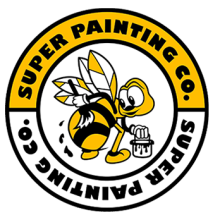In the world of home improvement, there are painters, and then there are super painting contractors — those individuals who have honed their craft to perfection. If you’re eager to transform your living space with a fresh coat of paint and are determined to achieve professional-level results, you’re in for a treat. Join us as we embark on a journey guided by seasoned expertise, unveiling the well-guarded secrets, expert techniques, and invaluable insights that can help you elevate your painting projects to a whole new level.
Whether you’re an expert DIY enthusiast or a novice looking to learn the ropes, this article is your ticket to unlocking the artistry of painting and transforming your living space into a masterpiece. So, grab your paintbrushes and roller sleeves, and let’s embark on this painting adventure together, guided by the expertise of a true master of the craft.
18 Secret Tips and Techniques by Professional Painters at Super Painting
Clear the Room Completely Before Beginning Painting
For items too bulky to remove from the room, relocate them to the room’s center and shield them with plastic covers. Opt for canvas drop cloths, which remain securely in place without the need for tape and offer better slip resistance than plastic.
Prevent Drips during Painting
When it comes to safeguarding woodwork, masking tape performs admirably if applied correctly. Begin by eliminating all dirt and grime along the trim edge with a damp cloth. Position the tape tightly against the wall and unroll it to cover the edge. Press the tape firmly against the wood with a putty knife along its entire length. Employ painter’s tape that is at least twice as wide as the trim and leave it slightly flared out to protect the trim’s front from paint drips.
Upon completion, promptly remove the tape while the paint is still wet or wait until it’s completely dry the following day. Attempting to remove it when the paint is partially dry may result in peeling off fresh paint along with the tape.
Thoroughly Dust and Vacuum
Upon completing the initial sanding and scraping, eliminate all residual dust with an old paintbrush and employ a vacuum with a brush attachment to thoroughly clean the woodwork.
Fill All Holes, Including Minor Ones
Don’t assume that a fresh coat of paint will mask tiny dents and scratches; it won’t. In fact, a new paint layer will accentuate minor flaws. Employ spackling compound to fill dents less than 1/8 inch deep. For deeper holes, opt for a two-part filler or an epoxy wood filler, although these may require some effort and the mixing of small batches. However, the resulting patches will withstand considerable wear and tear without dislodging.
Sequence Matters: Trim, Ceilings, Walls
The long-awaited revelation is here. Professional painters adhere to a specific order when tackling a room. They commence with the trim (utilizing the indispensable Bucket Edge tool, which prevents any paint mishaps on adjacent surfaces), followed by the ceiling, and then proceed to the walls. This strategic sequence makes sense because taping off trim is more efficient than taping off entire walls, saving precious time.
When painting trim, precision isn’t essential; the focus is on achieving a smooth wood finish. Any inadvertent paint on doors or trim that spills onto the walls will be concealed during the wall-painting phase. After the trim has been fully painted and allowed to dry (at least 24 hours), carefully tape it off with “easy release” painter’s tape, and then move on to painting the ceiling and subsequently the walls.
Removing Lap Marks in Wall Painting
Lap marks, those unsightly streaks resulting from uneven paint buildup, are a common nuisance during wall painting. They occur when paint is rolled over an already partially dried surface (latex paint can stiffen rapidly in warm, dry conditions. To thwart lap marks, maintain a “wet edge” throughout the painting process, ensuring that each roller stroke overlaps the previous one before the paint begins to dry.
To sustain a wet edge, paint an entire wall in one continuous session. Start at one end, running the roller up and down the full height of the wall, slightly shifting it with each stroke. Adjust your position when necessary to rectify thick spots or runs. Avoid letting the roller become overly dry; reload it frequently to ensure it remains at least half-loaded.
Keep the open side of the roller frame facing the already painted area, minimizing pressure on the open side and reducing the likelihood of leaving paint ridges?
Consider Liquid Sandpaper, Particularly for Lead Paint
After the final sanding and vacuuming, some professional painters go the extra mile by wiping down the woodwork with a liquid de-glosser. This step ensures a robust bond. For those dealing with lead paint, this approach can serve as a replacement for sanding.
Create a Polished Finish by Applying neat beads of Caulk between Woodwork and Walls
Elevate your project to professional standards by carefully applying a slender line of paintable acrylic latex caulk exclusively within the crevice where woodwork and walls converge. Afterward, expertly remove any surplus caulk with a putty knife. To streamline your efforts and reduce potential frustrations, consider investing in a dripless caulk gun. It’s crucial to select a caulk tip slightly smaller than your initial estimation for optimal precision.
Sand between Coats
Even with meticulous care, a freshly applied coat of paint or primer may still exhibit ridges, bubbles, or traces of dust and lint. For the smoothest topcoat possible, manually sand the entire surface after applying primer and between paint coats.
While this task might appear time-consuming, it typically consumes just five minutes when the door is positioned flat on sawhorses. Opt for non-clogging sandpaper rated at 180 or 220 grit, or select sanding sponges labeled as “non-clogging”. Apply gentle pressure to achieve a flawless surface, then eliminate dust by employing a vacuum cleaner and finishing by wiping the door with a damp cloth.
Give Wool-Blend Roller Covers a Spin
When it comes to your paint rolling setup, the roller cover, also known as a sleeve, takes center stage. While opting for the cheapest cover might be tempting, the difference a quality roller cover can make in your painting experience is well worth the minor extra cleanup effort. Bargain roller covers simply can’t hold an adequate amount of paint to do a proper job, potentially quadrupling the time needed to paint a room.
The result? An uneven paint layer, unsightly lap marks, and the emergence of paint ridges. Instead, consider investing in a 1/2-inch nap wool blend roller cover and give it a whirl. With proper maintenance, this could very well be the last roller cover you’ll ever need.
Apply Liberally, Then Smooth
When working with a brush for painting trim or other woodwork, a helpful technique involves loading the brush generously with paint and applying it liberally in small sections using short, brisk strokes. This initial application ensures sufficient paint coverage for working on the trim. Subsequently, blend the paint into the previously painted section and achieve a uniform finish using long finishing strokes in one direction.
Light up the Woodwork and Identify Imperfections
Place a handheld bulb (at least 60 watts) to cast light across the wood surface. This technique exposes loose paint, rough edges, and other surface blemishes, aiding in their identification and subsequent remediation. Use a pencil to gently circle the areas that require attention.
Preserve Brush Bristles with Cardboard
Without proper support, paintbrush bristles can curl or splay as they dry. An effective way to maintain their shape is to store brushes in the cardboard wrappers they originally came in. These wrappers serve a dual purpose; they not only protect the bristle shape but also help the brush dry properly after cleaning. If you’ve already discarded your brush wrappers, consider using paper and a rubber band as an alternative.
Cardboard: The Ultimate Floor Protector
For some, traditional drop cloths can be cumbersome, oversized, slippery, and messy, particularly when moving them around while they’re still covered in wet paint. This is why some opt for cardboard, placing it snugly against the wall and sliding it with their foot as they progress through the room.
No-Maintenance Paint Trays
Save yourself the trouble of using liners or cleaning your paint trays. Simply pour any excess paint back into the can and allow the paint inside the tray to dry completely before reusing it. Paint trays with a 1/8-inch-thick paint buildup in them are preferable because they are slightly heavier and won’t slide around while loading the roller.
Balancing Prep and Paint with 2/3 Prep, 1/3 Painting Approach
While the act of painting may capture the spotlight and allure, it’s crucial to allocate a significant portion of your time to the preparatory phase. The more meticulous your room’s preparation for a fresh coat of paint, the more exceptional the final results will be.
Prioritizing tasks like washing, cleaning, patching, sanding, and vacuuming walls, ceilings, trim, and doors before reaching for your paintbrush or roller is an investment of time that yields substantial dividends. Neglecting minor imperfections during this crucial phase can lead to them becoming conspicuous eyesores once the paint is applied.
Ceiling First, Then Walls
Before you start painting the walls, take a close look at your ceiling. If it seems in need of a refresh, begin by painting the ceiling first. You wouldn’t want to paint the walls and then find yourself needing to paint the ceiling in a few weeks or years. Painting the ceiling initially prevents the fine mist of paint from rolling onto everything below. Moreover, it allows for a less meticulous approach along the walls, as any paint that inadvertently reaches the wall surface can be easily covered during the subsequent wall-painting phase.
Skip Brush Cleaning Between Coats
When taking a break from painting or concluding your day’s work, place your brushes in a five-gallon bucket filled with clean water (ensure that all brushes in the bucket have the same color paint on them). When you’re ready to resume painting, swish the brushes in the water and spin out excess moisture using a paintbrush-and-roller spinner. Perform the spinning inside a second empty bucket to shield the surrounding walls from splashing water droplets.
End Note
Now armed with the insights and techniques shared by our Super Painting team, you’re well-equipped to embark on your next painting project with confidence. Remember, the key to a professional finish lies in the details, from proper preparation to meticulous execution.
So, whether you choose to tackle your painting endeavors on your own or opt for professional painters, make your next paint job a masterpiece. Happy painting!
If you’re ready to take your project to the next level, contact Super Painting Contractors today at 310-381-9027 and transform your space with precision and expertise.






escitalopram pill 20 is escitalopram controlled